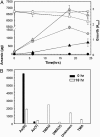Arsenic detoxification and evolution of trimethylarsine gas by a microbial arsenite S-adenosylmethionine methyltransferase
- PMID: 16452170
- PMCID: PMC1413689
- DOI: 10.1073/pnas.0506836103
Arsenic detoxification and evolution of trimethylarsine gas by a microbial arsenite S-adenosylmethionine methyltransferase
Abstract
In this article, a mechanism of arsenite [As(III)]resistance through methylation and subsequent volatization is described. Heterologous expression of arsM from Rhodopseudomonas palustris was shown to confer As(III) resistance to an arsenic-sensitive strain of Escherichia coli. ArsM catalyzes the formation of a number of methylated intermediates from As(III), with trimethylarsine as the end product. The net result is loss of arsenic, from both the medium and the cells. Because ArsM homologues are widespread in nature, this microbial-mediated transformation is proposed to have an important impact on the global arsenic cycle.
Conflict of interest statement
Conflict of interest statement: No conflicts declared.
Figures





Similar articles
-
Selective Methylation by an ArsM S-Adenosylmethionine Methyltransferase from Burkholderia gladioli GSRB05 Enhances Antibiotic Production.Environ Sci Technol. 2022 Oct 4;56(19):13858-13866. doi: 10.1021/acs.est.2c04324. Epub 2022 Sep 16. Environ Sci Technol. 2022. PMID: 36112513
-
Volatilization of arsenic from polluted soil by Pseudomonas putida engineered for expression of the arsM Arsenic(III) S-adenosine methyltransferase gene.Environ Sci Technol. 2014 Sep 2;48(17):10337-44. doi: 10.1021/es502230b. Epub 2014 Aug 14. Environ Sci Technol. 2014. PMID: 25122054 Free PMC article.
-
Identification and characterization of arsenite methyltransferase from an archaeon, Methanosarcina acetivorans C2A.Environ Sci Technol. 2014 Nov 4;48(21):12706-13. doi: 10.1021/es503869k. Epub 2014 Oct 22. Environ Sci Technol. 2014. PMID: 25295694
-
New mechanisms of bacterial arsenic resistance.Biomed J. 2016 Feb;39(1):5-13. doi: 10.1016/j.bj.2015.08.003. Epub 2016 Apr 1. Biomed J. 2016. PMID: 27105594 Free PMC article. Review.
-
The organoarsenical biocycle and the primordial antibiotic methylarsenite.Metallomics. 2016 Oct 1;8(10):1047-1055. doi: 10.1039/c6mt00168h. Metallomics. 2016. PMID: 27730229 Free PMC article. Review.
Cited by
-
Determination of physiological, taxonomic, and molecular characteristics of a cultivable arsenic-resistant bacterial community.Environ Sci Pollut Res Int. 2015 Sep;22(18):13753-63. doi: 10.1007/s11356-014-3840-5. Epub 2015 Feb 27. Environ Sci Pollut Res Int. 2015. PMID: 25721523
-
Microbial Oxidation of Arsenite: Regulation, Chemotaxis, Phosphate Metabolism and Energy Generation.Front Microbiol. 2020 Sep 15;11:569282. doi: 10.3389/fmicb.2020.569282. eCollection 2020. Front Microbiol. 2020. PMID: 33072028 Free PMC article. Review.
-
ArsP: a methylarsenite efflux permease.Mol Microbiol. 2015 Nov;98(4):625-35. doi: 10.1111/mmi.13145. Epub 2015 Aug 22. Mol Microbiol. 2015. PMID: 26234817 Free PMC article.
-
Organoarsenical tolerance in Sphingobacterium wenxiniae, a bacterium isolated from activated sludge.Environ Microbiol. 2022 Feb;24(2):762-771. doi: 10.1111/1462-2920.15599. Epub 2021 May 27. Environ Microbiol. 2022. PMID: 33998126 Free PMC article.
-
Transcriptomic Analysis of Two Thioalkalivibrio Species Under Arsenite Stress Revealed a Potential Candidate Gene for an Alternative Arsenite Oxidation Pathway.Front Microbiol. 2019 Jul 4;10:1514. doi: 10.3389/fmicb.2019.01514. eCollection 2019. Front Microbiol. 2019. PMID: 31333619 Free PMC article.
References
Publication types
MeSH terms
Substances
Grants and funding
LinkOut - more resources
Full Text Sources
Other Literature Sources
Medical
Molecular Biology Databases
Research Materials

